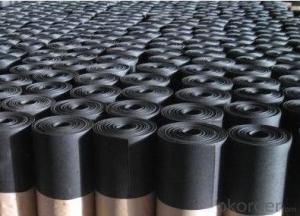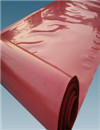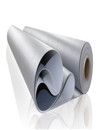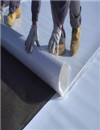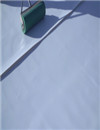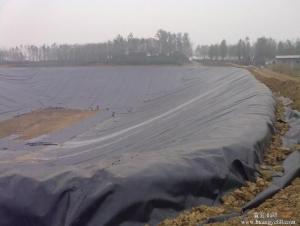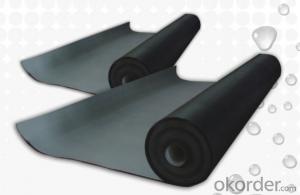EPDM Waterproof Membrane for Roofing Industry
- Loading Port:
- Qingdao
- Payment Terms:
- TT or LC
- Min Order Qty:
- 20000 m²
- Supply Capability:
- 600000 m²/month
OKorder Service Pledge
OKorder Financial Service
You Might Also Like
Product Description of EPDM Waterproof Membrane for Roofing Industry
1.EPDM Waterproof Membrane / Roofing Material / Sheets Roofing
2.High tensile strength.
3.Good elongation.
4.UV resistant.
5.Anti-corrosion.
Product instruction of EPDM Waterproof Membrane for Roofing Industry
EPDM waterproof membrane is made from ternary ethylene-propylene rubber. With the best performance among high polymer waterproof materials, EPDM is of exceptional elasticity and will not split or crack under normal building movement.
Features of EPDM Waterproof Membrane for Roofing Industry
1) Excellent weather-ability, durability and size stability
2) Good adaptability to high and low temperature, UV resistant and anti-corrosion
3) High tensile strength and good elongation, accommodating to structure movement
4) Easy installation, solid joint, and no environmental pollution
5) Good rooting penetration resistance
6) Service life up to 50 years
Application of EPDM Waterproof Membrane for Roofing Industry
1) Roofs, Basement, Toilet
2) Industrial and civil building waterproofing
3) Geo-synthetic liner for swimming pool, channels, irrigation system
4) Especially suit for projects with high requirements in durability, anti-corrosion and deformation
Technical Parameters of EPDM Waterproof Membrane for Roofing Industry
EPDM Waterproof Membrane ASTM Standard : D-7465 | ||||
Property | Test Method | Units | Mininum ASTM | |
D-7465 | ||||
Sl | Eng | |||
Specific Gravity | ASTM D-792 | gm/cc | 1.1 | 1.1 |
Unit Weight | ASTM D-751 | kg/m2 | 1.3 | 0.27 |
Thickness Type 1 | ASTM D-412 | mm(in) | 1.02 | 0.04 |
Tensile Strength. Die C | ASTM D-412 | Mpa(psi) | 9 | 1305 |
Ultimate Elongation,Die C | ASTM D-412 | % | 300 | 300 |
Tear Resistance,Die C | ASTM D-624 | Kn/m(lbf/in) | 26.27 | 150 |
Puncture Resistance | ASTM D-4833 | N(lbs) | 133 | 30 |
Shore A Durometer | ASTM D-2240 | 65-10 | 65-10 | |
Ozone Resistance | ASTM D-1149 | No Crack | No Crack | |
Multiaxial Elongation | ASTM D-5617 | % | 100 | 100 |
Heat Aging 28 days at 240 degrees | ASTM D-573 | |||
Tensile Strength, Die C | ASTM D-412 | MPa(psi) | 8.3 | 1205 |
Ultimate elongation, Die C | ASTM D-412 | % | 200 | 200 |
Tear Resistance, Die C | ASTM-624 | Kn/m(lbf/in) | 21.9 | 125 |
Accelerated Aging Xenon Arc | ASTM G-155/G-151 | Pass | Pass | |
Brittleness Point | ASTM D-2137 | -45 °C | -49 °C F | |
Water Absorption | ASTM D-471 | % | +8,-2 | +8,-2 |
Water Vapor Permeability, max | ASTM E-96 | Permils | 2.0 | 2.0 |
Linear Dimensional Change,max | ASTM-D-1204 | % | +/-1.0 | +/-1.0 |
Chronic Toxicity Screening | EPA/600/4-89/001 | Method 1000.0 | Pass | Pass |
FAQ:
1. What are we supplying?
We are specialized in producing Colorful Asphalt Roof Shingle, SBS/APP modified bitumen waterproof membrane, Self adhesive bitumen waterproof membrane, PVC waterproofing membrane, EPDM rubber roofing membrane, Single Component Polyurethane Waterproof Coating, and Spray Polyurea Waterproof Coating
2. What is your main market?
Our EPDM Waterproof Membrane for Roofing Industry sells very well in USA, United Kingdom, Austrilia, Canada, Japan, Pakistan, etc.
3. What is your advantage for EPDM Waterproof Membrane for Roofing Industry ?
With the most advanced production line, our good quality is based on superior material imported from America.
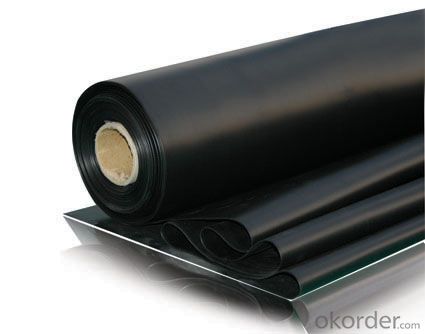

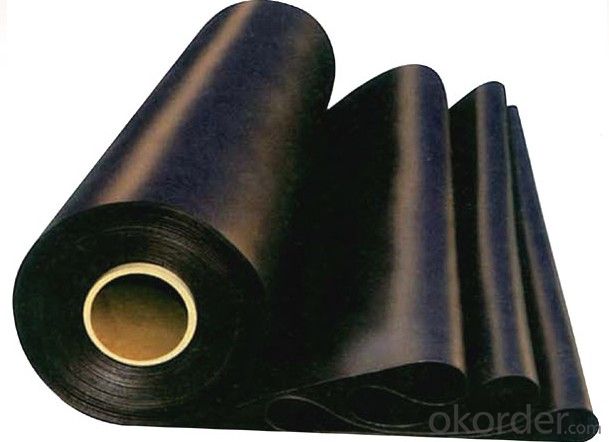
- Q: Can a waterproofing membrane be used for foundation repair?
- Yes, a waterproofing membrane can be used for foundation repair. Waterproofing membranes are commonly used to prevent water intrusion and can be applied to foundation walls to seal any existing cracks or gaps, preventing further damage or leaks. Additionally, they can help improve the overall strength and durability of the foundation, providing long-lasting protection against water damage.
- Q: Can a waterproofing membrane be used on metal block surfaces?
- Metal block surfaces can indeed benefit from the use of a waterproofing membrane. These membranes are specifically designed to form a barrier against water and moisture, and they are versatile enough to be applied to various types of surfaces, including metal. By adhering to the metal surface, the membrane creates a protective layer that not only prevents water infiltration but also safeguards the metal against rust and corrosion. However, it is crucial to guarantee that the metal surface is thoroughly cleaned, dried, and appropriately prepared before the application of the waterproofing membrane. This preparation ensures optimal adhesion and effectiveness. For specific instructions on using a waterproofing membrane on metal block surfaces, it is highly recommended to consult a professional or refer to the manufacturer's guidelines.
- Q: Can a waterproofing membrane be used in conjunction with energy-efficient building designs?
- Indeed, energy-efficient building designs can benefit greatly from the utilization of a waterproofing membrane. By integrating this membrane into the construction process, numerous advantages can be achieved. To begin with, the presence of a waterproofing membrane plays a vital role in shielding the building envelope from water infiltration. This aspect is crucial as it ensures the structure's integrity and longevity. By preventing water damage, the building is able to avoid costly repairs and potential energy losses caused by moisture intrusion. Moreover, a well-designed waterproofing system can contribute significantly to the energy efficiency of the building by minimizing the reliance on mechanical heating and cooling. By effectively blocking moisture from entering the building envelope, the waterproofing membrane helps to maintain a consistent indoor temperature. Consequently, this reduces the burden on HVAC systems and enhances overall energy efficiency. Furthermore, specific types of waterproofing membranes possess reflective or heat-resistant properties that can further contribute to energy savings. These membranes are capable of reflecting solar radiation, thereby diminishing the amount of heat absorbed by the building. As a result, the demand for cooling is reduced. Lastly, it is important to note that waterproofing membranes can be seamlessly integrated with other energy-efficient building components such as green roofs or rainwater harvesting systems. These additional systems not only aid in reducing energy consumption but also provide insulation, decrease stormwater runoff, and promote sustainable water management practices. Overall, the incorporation of a waterproofing membrane in energy-efficient building designs elevates both the durability and energy performance of the structure. It offers protection against water damage, lessens the load on mechanical systems, and can be harmoniously integrated with other sustainable features, thus making it a highly valuable component of energy-efficient building designs.
- Q: Can a waterproofing membrane be used in areas with chemical exposure?
- Yes, a waterproofing membrane can be used in areas with chemical exposure. However, it is important to select a waterproofing membrane that is specifically designed to withstand chemical exposure. Not all waterproofing membranes are created equal, and some may not be suitable for use in areas with chemical exposure. Chemical-resistant waterproofing membranes are typically made from materials such as polyurethane, epoxy, or polyurea, which are known for their resistance to various chemicals. These membranes are designed to provide a protective barrier against moisture and chemicals, preventing them from seeping into the underlying surfaces. When choosing a waterproofing membrane for areas with chemical exposure, it is crucial to consider the specific chemicals that will be present. Different chemicals can have different effects on materials, so it is essential to select a membrane that is specifically designed to resist the chemicals in the environment. Consulting with a professional or manufacturer is recommended to ensure the appropriate selection of a chemical-resistant waterproofing membrane for the specific application.
- Q: Can a waterproofing membrane be used for docks or marinas?
- Indeed, docks or marinas can utilize a waterproofing membrane to great effect. In construction, waterproofing membranes are widely employed to create a barrier that prevents water from infiltrating. In the case of docks or marinas, where constant contact with water is anticipated, a waterproofing membrane becomes a valuable solution for safeguarding the structure against water-related harm. Typically composed of rubber, PVC, or modified bitumen, waterproofing membranes are engineered to withstand water pressure and impede water from seeping into the structure. They are applied as a continuous layer over the surface, forming an airtight seal. The installation of a waterproofing membrane on docks or marinas serves to fend off water intrusion, which can cause gradual damage. Over time, water damage can lead to structural decay, wood rot, corrosion of metal components, and the proliferation of mold or mildew. Additionally, a waterproofing membrane can provide defense against other elements like UV rays, chemicals, and oil spills. It is imperative to select a waterproofing membrane specifically designed for marine environments. This ensures the ability to withstand the distinct challenges presented by saltwater, fluctuating water levels, and continuous exposure to waves and tides. Additionally, adhering to proper installation procedures and maintenance guidelines is crucial for ensuring the longevity and effectiveness of the waterproofing membrane. To sum up, a waterproofing membrane is a suitable solution for protecting docks or marinas from water damage. It establishes a dependable barrier against water infiltration, thereby prolonging the lifespan of the structure and reducing maintenance needs.
- Q: Can a waterproofing membrane be applied to existing structures?
- Existing structures can have a waterproofing membrane applied to them. Applying a waterproofing membrane is a commonly used and effective method for preventing water infiltration and damage to buildings. Whether it's a concrete structure, roof, or basement, waterproofing membranes can be installed on the inside or outside surfaces to create a barrier against water penetration. There are various types of waterproofing membranes available, including liquid-applied, sheet, and spray-applied membranes, which can be chosen based on the specific needs of the structure. The process of applying a waterproofing membrane to an existing structure typically involves thorough surface preparation, such as cleaning, repairing any existing cracks or damages, and ensuring a smooth surface. Once the surface is prepared, the membrane is applied using the recommended method to ensure proper adhesion and coverage. Waterproofing membranes are designed to withstand environmental factors like UV rays, temperature changes, and water pressure, providing long-lasting protection for existing structures. However, it's important to consult a professional waterproofing contractor to assess the condition of the structure and determine the most suitable and effective waterproofing solution.
- Q: Can a waterproofing membrane be used on aerated concrete block surfaces?
- Yes, a waterproofing membrane can be used on aerated concrete block surfaces. The membrane helps to prevent water penetration, protecting the aerated concrete blocks from moisture damage and increasing their longevity.
- Q: Can a waterproofing membrane be used on plastic block surfaces?
- Indeed, it is possible to utilize a waterproofing membrane on surfaces composed of plastic blocks. These membranes are specifically engineered to serve as a safeguard against moisture, effectively hindering water infiltration. Similar to any other type of surface, plastic blocks are prone to water-related harm if not adequately shielded. By applying a waterproofing membrane, one can successfully seal and safeguard the plastic blocks, thus thwarting water permeation and potential destruction. To achieve optimal outcomes, it is crucial to select a waterproofing membrane that harmonizes with plastic materials and adhere to the manufacturer's application guidelines.
- Q: Can a waterproofing membrane be used for water tanks?
- Yes, a waterproofing membrane can be used for water tanks. Waterproofing membranes are specifically designed to prevent the passage of water and can effectively seal water tanks, ensuring that they remain watertight. These membranes are commonly made from materials such as bitumen, PVC, or EPDM, which provide excellent resistance to water and are capable of withstanding the harsh conditions often found in water tanks. Additionally, waterproofing membranes can be applied to various surfaces, including concrete, metal, and masonry, making them versatile and suitable for different types of water tanks. Overall, using a waterproofing membrane is a reliable solution for ensuring the integrity and longevity of water tanks by preventing water leakage and protecting the surrounding environment from potential water damage.
- Q: Does a waterproofing membrane require any specific curing time before it can be exposed to water?
- Yes, a waterproofing membrane generally requires a specific curing time before it can be exposed to water. The curing time allows the membrane to fully dry, set, and create a strong bond with the substrate it is applied to. This ensures its effectiveness in preventing water penetration. The specific curing time can vary depending on the type of membrane and manufacturer's instructions, so it is crucial to follow the recommended curing period before subjecting it to water exposure.
Send your message to us
EPDM Waterproof Membrane for Roofing Industry
- Loading Port:
- Qingdao
- Payment Terms:
- TT or LC
- Min Order Qty:
- 20000 m²
- Supply Capability:
- 600000 m²/month
OKorder Service Pledge
OKorder Financial Service
Similar products
Hot products
Hot Searches
Related keywords
